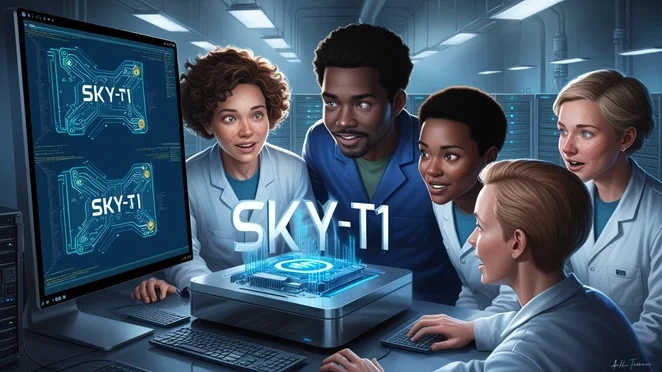The Article Tells The Story of:
- Researchers at UC Berkeley have developed Sky-T1, a highly affordable reasoning AI model.
- It was trained for less than $450, a significant cost reduction compared to earlier models.
- Sky-T1 outperforms previous AI models on various benchmarks, but faces challenges in some domains like physics.
- NovaSky plans to further refine this model to enhance efficiency and accuracy.
In a major advancement for artificial intelligence, researchers at UC Berkeley’s Sky Computin g Lab have unveiled Sky-T1, a reasoning model that costs under $450 to develop. This achievement is a game-changer in the AI industry, marking a shift toward making high-level reasoning models more affordable and accessible to a wider range of developers and researchers.
Key Developments in Sky-T1 AI Reasoning
- Cost-Efficiency Revolution:
The cost of training AI models has traditionally been extremely high, often running into the millions of dollars. However, Sky-T1 demonstrates that it is now possible to build and train reasoning AI models at a fraction of that cost. Trained for less than $450, Sky-T1 challenges the assumption that high-performance models require massive investments. This significant reduction in training costs is largely driven by the use of synthetic training data, which helps keep expenses manageable. - Performance Benchmarks and Achievements:
Sky-T1 has been tested on several benchmarks, showing impressive results. For example, it outperforms the earlier version of OpenAI’s o1 model on key challenges like MATH500, a set of competitive-level math problems. It also does better than the preview of o1 on LiveCodeBench, a coding evaluation used to assess AI models’ programming capabilities. These achievements highlight the model’s effectiveness in areas that demand strong reasoning and problem-solving skills.Despite its success, Sky-T1 is not without its limitations. When tested on the GPQA-Diamond benchmark—focused on advanced subjects like physics, biology, and chemistry—the model falls short compared to o1. This benchmark contains questions that require a deeper understanding of these subjects, posing a challenge that Sky-T1 has yet to fully overcome. - Data Sources and Training Process:
To create Sky-T1, the research team at NovaSky used a combination of data sources. Initially, they leveraged Alibaba’s QwQ-32B-Preview model to generate synthetic training data. They then curated this data mixture, refining it with OpenAI’s GPT-4o-mini model to improve its usability. The training process took around 19 hours using a rack of 8 Nvidia H100 GPUs, and the model contains 32 billion parameters, which is a measure of the model’s complexity and problem-solving capacity.This innovative approach, including the use of synthetic data and high-performance GPUs, helped make the training process efficient and affordable. As AI models grow more complex, these methods could become standard practice in the development of advanced reasoning AI. - Looking Ahead: Future Improvements and Challenges:
Although Sky-T1 shows great promise, it is still in the early stages of development. The model is currently less capable than the final release of OpenAI’s o1, and it faces challenges in specialized fields like physics and biology. OpenAI is expected to release even more powerful models in the future, including the upcoming o3, which could outpace Sky-T1 in terms of reasoning ability.However, the team behind Sky-T1 is focused on making the model even better. They plan to work on improving its efficiency and accuracy, particularly in domains where it currently struggles. As the NovaSky team continues to refine Sky-T1, they aim to develop more efficient models without sacrificing reasoning performance, pushing the boundaries of what’s possible with open-source AI.
Conclusion
Sky-T1 marks a turning point in the development of open-source reasoning AI models. By significantly reducing the cost of training while maintaining competitive performance, it has the potential to reshape the landscape of AI research. As the team continues to refine the model, the future looks promising for more affordable, effective, and accessible AI systems. Stay tuned as Sky-T1 evolves, with future updates expected to further push the limits of AI reasoning and problem-solving.
This innovation paves the way for an exciting new chapter in AI development, where advanced models become increasingly accessible, efficient, and impactful.
Stay Updated: Artificial Intelligence


